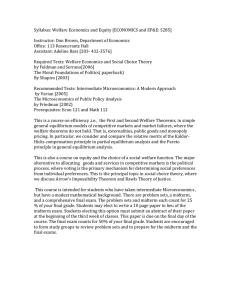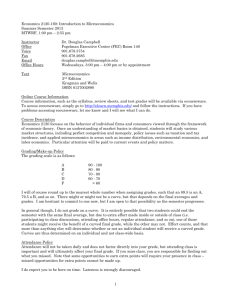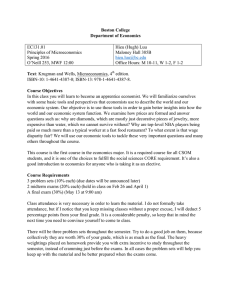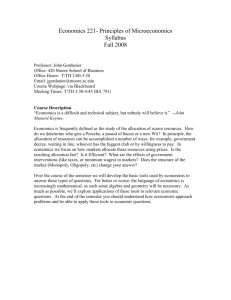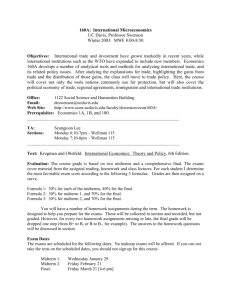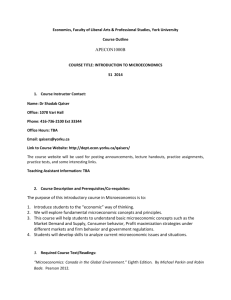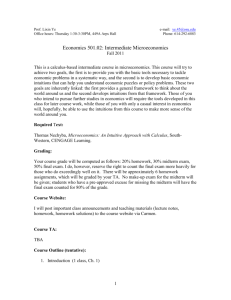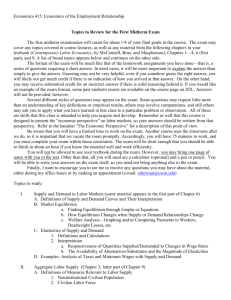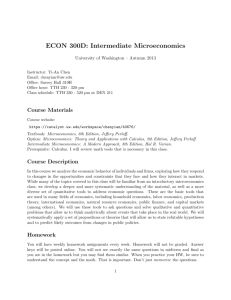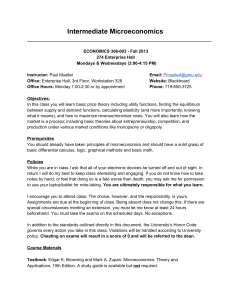Case Karl E., Fair Ray C., Oster Sharon M., Principles of Economics
advertisement
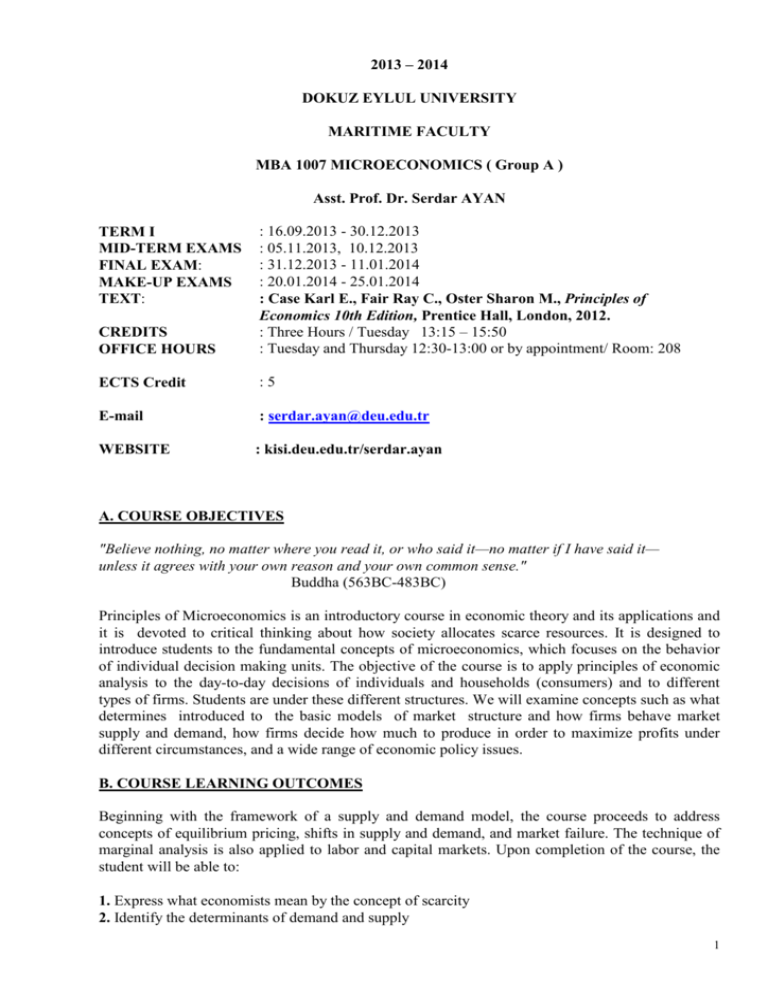
2013 – 2014 DOKUZ EYLUL UNIVERSITY MARITIME FACULTY MBA 1007 MICROECONOMICS ( Group A ) Asst. Prof. Dr. Serdar AYAN CREDITS OFFICE HOURS : 16.09.2013 - 30.12.2013 : 05.11.2013, 10.12.2013 : 31.12.2013 - 11.01.2014 : 20.01.2014 - 25.01.2014 : Case Karl E., Fair Ray C., Oster Sharon M., Principles of Economics 10th Edition, Prentice Hall, London, 2012. : Three Hours / Tuesday 13:15 – 15:50 : Tuesday and Thursday 12:30-13:00 or by appointment/ Room: 208 ECTS Credit :5 E-mail : serdar.ayan@deu.edu.tr WEBSITE : kisi.deu.edu.tr/serdar.ayan TERM I MID-TERM EXAMS FINAL EXAM: MAKE-UP EXAMS TEXT: A. COURSE OBJECTIVES "Believe nothing, no matter where you read it, or who said it—no matter if I have said it— unless it agrees with your own reason and your own common sense." Buddha (563BC-483BC) Principles of Microeconomics is an introductory course in economic theory and its applications and it is devoted to critical thinking about how society allocates scarce resources. It is designed to introduce students to the fundamental concepts of microeconomics, which focuses on the behavior of individual decision making units. The objective of the course is to apply principles of economic analysis to the day-to-day decisions of individuals and households (consumers) and to different types of firms. Students are under these different structures. We will examine concepts such as what determines introduced to the basic models of market structure and how firms behave market supply and demand, how firms decide how much to produce in order to maximize profits under different circumstances, and a wide range of economic policy issues. B. COURSE LEARNING OUTCOMES Beginning with the framework of a supply and demand model, the course proceeds to address concepts of equilibrium pricing, shifts in supply and demand, and market failure. The technique of marginal analysis is also applied to labor and capital markets. Upon completion of the course, the student will be able to: 1. Express what economists mean by the concept of scarcity 2. Identify the determinants of demand and supply 1 3. Predict a change in market outcomes given a change in supply and demand 4. Explain the concept of market types and equilibrium C. EXAMS AND EVALUATION There will be two midterm and one final exam covering the prior lecture and reading material. Midterm and final exams will be composed of essay type questions that encourages the critical thinking in microeconomics discipline. Evaluation system is as follows; Midterm Exam ( 1 ) Midterm Exam ( 2 ) Final Exam TOTAL 20 % 20 % 60 % 100 % D. RULES FOR ATTENDANCE All students are expected to attend classes punctually and regularly. Access to the final exam will be granted to students who attain an attendance in excess of 70 %. The content of the syllabus can be changed by the instructor at any time by informing the related department’s head. Class participation includes attendance, discussion and participation. Role is taken at the beginning of class using a seating chart. Students arriving late may request partial credit by seeing me after class. Excessive lateness or absences will result in a geometrically reduced grade. Please make your travel plans accordingly. As one shrewd person once put it, “Never underestimate the value of showing up.” Your presence enriches not only yourself, but also your classmates. Class time is generally devoted to Socratic discussion and debate. You will be called upon frequently: in fact, you can expect be called on in every class session. If you are a bit shy, this can be intimidating. I hope that over time you will grow in confidence to speak up and be heard. Sometimes the quietest students have the most interesting and important things to say. STUDY HINTS: There are no surprises about how to excel in economics. Come to class prepared each day. You should actively practice retrieving stored information and applying it. The more you practice, the easier it gets. A Study Guide is an excellent learning tool; use it to the fullest. Obviously, you cannot master everything at once, but it will become quite apparent if you are preparing for class or not. If you are unavoidably absent, please arrange to get the notes and assignments from a classmate in time for the next session. E.REFERENCES 1. Lipsey, Richard G. , Courant Paul N., Ragan, Christopher T. S., Economics, 12th Edition, Addison-Wesley Publishing Company, United States, 2000. 2. Baumol, William J., Blinder Alan S., Economics : Principles and Policy , Harcourt Brace Jovanovich Publication, New York, 2000. 3. Begg David, Fischer Stanley, Dornbuch Rudiger , Economics, 5th Edition, McGraw Hill Publication, England, 2008. 2 F. TENTATIVE SCHEDULE WEEK 1 DATE 17.09.2013 2 24.09.2013 TOPICS Introduction to Course Chapter 1 : The Scope and The Method of Economics Chapter 2 : The Economic Problem : Scarcity and Choice 3 01.10.2013 Chapter 3 : Demand, Supply and Market Equilibrium 4 08.10.2013 Chapter 5 : Elasticity 5 15.10.2013 RELIGIOUS HOLIDAY ( Sacrifice Feast ) 6 22.10.2013 Chapter 6 : Household Behavior and Consumer Choice 7 29.10.2013 NATIONAL HOLIDAY ( Republic Day ) 8 05.11.2013 9 12.11.2013 Chapter 7 : The Production Process : The Behavior of Profit-Maximizing Firms 10 19.11.2013 Chapter 8 : Short-Run Costs and Output Decisions 11 26.11.2013 Chapter 9 : Long-Run Costs and Output Decisions 12 03.12.2013 Chapter 12 : General Equilibrium and The Efficiency of Perfect Competition 13 10.12.2013 MIDTERM EXAM 2 14 17.12.2013 Chapter 13 : Monopoly 15 24.12.2013 Chapter 14 : Oligopoly ( and Duopoly) MIDTERM EXAM 1 3
